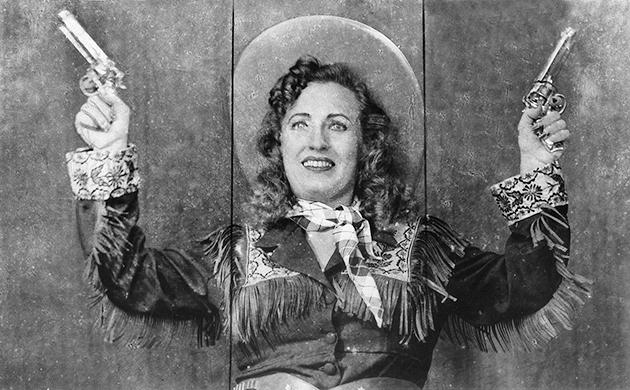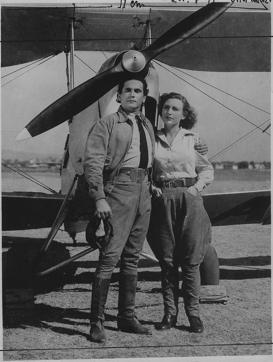Wadia and Nadia: How love kicked in pre-Bollywood filmdom
Meet the father of Indian stunt movies, Homi Wadia, and his fearless stuntwoman wife
It’s called riding the zeitgeist. And in the ’30s, in pre-Bollywood Bollywood, two filmmaking and action-film junkies, Homi and JBH Wadia, did just that.

It was the era of the swashbuckling Douglas Fairbanks in Hollywood. At home, a wrestler, Master Vithal, was the hero of the silent stunt films rolling out of the trend-setting Sharda Studios. Nadia — the blue-eyed, ballet-trained, big-hipped, blonde Scot — became crucial to the Wadia brothers’ attempts to the turn the stunt into an art form.
Nadia was a JBH discovery. But it was Homi (May 22, 1911 - December 10, 2004) who gave this memsahib with a thick Scottish accent, a voice. “Homi realised her language was her ‘body’,” says film theorist and curator Amrit Gangar. “He kept Nadia’s dialogue to a bare minimum because of her difficulty with Hindi.” He directed her in six films — Hunterwali, Pahadi Kanya, Miss Fronter Mail, Lutaru Lalna, Punjab Mail and Diamond Queen — combining his brother’s inclination for social messages (JBH was a follower of Radical Humanist MN Roy) and his own preference for unadulterated action films.

Nadia was not just a stunt heroine, she was the stunt queen of the new sound era. When Indians lined up to watch a Homi Wadia film with Nadia as heroine, they got the works — kicks, whips, chairs thrown about, the puff-puff of train engines, horse races, a stuntwoman nuzzling lions. Her fierce yell — “Hey-y-y” — at stray animals, bandits, and bad boys in general, as she cycled down the road on her way to new adventures, was her signature.
Homi moulded Nadia into a Wadia Movietone (a company the brothers founded in 1933) heroine. Certainly, in the Wadia scheme of things, she was no less than Devika Rani, the star and mistress of the major production house, Bombay Talkies.
Read: Interview with Anthony Thasan, the ex-LTTEman, hero of the 2015 Palme d’Or film in Cannes
Entire costume-dramas and Oriental fantasies with nationalist undertones were thought of with Nadia in mind. She was tutored in Hindi and in sari-wearing. The Wadias’ best stuntmen, Boman Shroff and Ustad Haqu, taught her to kick and punch. In many of her films, she beat up government servants in Her Majesty’s service. In the films’ promotion material, she was packaged as a ‘Bombay-wali’ and a ‘Brave Indian girl who sacrificed royal luxuries in the cause of her people and country’ — truth be damned. (Nadia, the daughter of a Scottish World War II soldier, was among the floating population of British citizens who streamed into Bombay from various posts after the War.) This build-up ensured that her complexion remained a non-issue.
But was it enough to ensure the stunt films’ success or make its leading lady, a non-Indian, acceptable to the movie-going masses? Initially, Homi was a Nadia sceptic, says film historian Mihir Bose, in his book, Bollywood: A History. A White woman giving Indian men a thrashing at the time of the freedom struggle could not be good for business. Producer MB Billimoria agreed. Hunterwali (1935), Nadia’s best-known film and her ticket to eventual stardom, was therefore strategised to the last detail.
Bose writes in his book that “Indianising her was a project from the beginning”. A foreign journalist who interviewed Nadia, he notes, had commented on the Wadias packaging her as if she was India’s Pearl White [the American stage and film actress]. This was meant to “attract all the glamour of the Pearl White brand while simultaneously constructing an all-India Nadia and thereby conflate traditions — the stunt queen tradition with that of legendary Indian warrior women”. Say, Rani Laxmibai or Durgawati.
A Homi-directed Nadia film also appealed in other ways. She was the male-villain-conquering heroine, says Gangar. Several American actresses “proved that the ‘weaker sex’ could perform amazing physical feats. So did Nadia without a stunt double. Large sections of movie-going Indians liked a woman fighting oppression and helping the poor like Robin Hood,” he adds.
Nadia and Wadia (Homi) married in 1961. According to some accounts, love struck after their fourth movie. Homi gave her the name Fearless Nadia after she sportingly jumped off the roof of a studio set during a shoot. The marriage was, for both, a happy landing.
Read: Bollywood doesn’t need more reality, it needs truth says Nawazuddin Siddiqui
Get more updates from Bollywood, Amar Singh Chamkila Review, Hollywood, Music and Web Series along with Latest Entertainment News at Hindustan Times.




